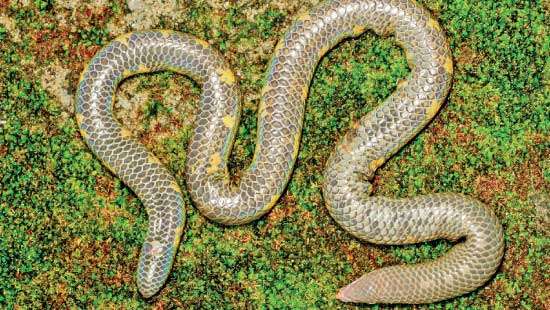A group of researchers, including one of the leading herpetologists in Sri Lanka, Mendis Wickramasinghe and Herpetology Researcher at Natural History Museum, London, Evolutionary Biologist Dr. David Gower, has been able to discover two species of snakes endemic to Sri Lanka in Riverston and Rassagala, Balangoda in the Knuckles mountain range.
Researches say that with these two discoveries, the number of endemic snakes in Sri Lanka increases to 108 and the number of shieldtail snakes increases to 18.
This new species of snakes discovered in Riverston area of Knuckles mountain range situated at an elevation of 1400 metres above the sea level, show similarity to Phillip’s Earth Snake in its outward appearance. This new species has been named Gunasekara’s Shieldtail.
The snake has been named in honor of the former Director General of Customs as well as an environmentalist, Samantha Gunasekara who established a Biodiversity Culture and National Heritage Protection branch for the first time in Sri Lanka Customs
Samantha Gunasekara
The snake has been named in honor of the former Director General of Customs as well as an environmentalist, Samantha Gunasekara who established a Biodiversity Culture and National Heritage Protection branch for the first time in Sri Lanka Customs and dedicated his time to prevent the smuggle of biological resources through the Customs and to safeguard environmental resources for the future generation, said Mendis Wickramasinghe.
“:We came across this species during our expedition to discover unexplored animal species in Knuckles. First, I believed that this species was the species of shieldtail snakes known as Phillip’s Earth Snake which was discovered by a researcher in Gammaduwa in the northern part of the mountain range in 1929. When I compared the two species, I understood that they were different from one another. Then, we began to explore this new species, he added. There are several differences between the new species and Phillip’s Earth Snake.
Gunasekara’s Shieldtail was comparatively shorter and its tail lacked lines as similar to Phillip’s Earth Snake. It also lacked two extensions in its tail and had more than seven lines in the abdomen as opposed to Phillip’s Earth Snake,”.
He also said that Dulan Ranga Widanapathirana, one of the most reputed young researchers in Sri Lanka, and other researchers including Nethu Wickramasinghe, Dr. David Gower participated in this exploration and Dushantha Wasala and Sanjaya Kanishka assisted him in the exploration.
Herpetology Researcher at Natural History Museum, London, Evolutionary Biologist Dr. David Gower has been able to introduce another species of snake endemic to Sri Lanka in an exploration carried out in Rassagala, Balangoda. He has named this new species as Rhinophis mendis as a tribute to the 28 years of service of the leading herpetologists in Sri Lanka, Mendis Wickramasinghe during which he conducted research about amphibians and reptiles in Sri Lanka and discovered more than 30 species of amphibians and reptiles endemic to Sri Lanka.
In its external appearance, this new species shows much similarity to Rhinophis homolepis and is limited to Rassagala area. The first sample of this species is said have been collected during 1894-1925. Other samples collected from Rakwana, Wellawaya and Godigamuwa which are similar to Rhinophis homolepis and Rhinophis mendis could be of other new species and therefore more research should be carried out, Dr. Gower said.
Researchers believe that the main factor which distinguishes Rhinophis mendis from Rhinophis homolepis is its limited number of scales on the abdomen. Additionally, the surface area of the rostral scale of Rhinophis mendis is more pointed than that of Rhinophis homolepis.
Small Grants Programme of the UN Environment Programme, Dilmah Company and Commercial Bank have provided funds for the researchers.
In its external appearance, this new species shows much similarity to Rhinophis homolepis and is limited to Rassagala area. The first sample of this species is said have been collected during 1894-1925
Mendis Wickramasinghe



